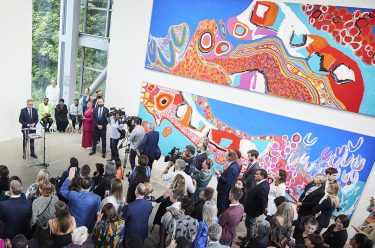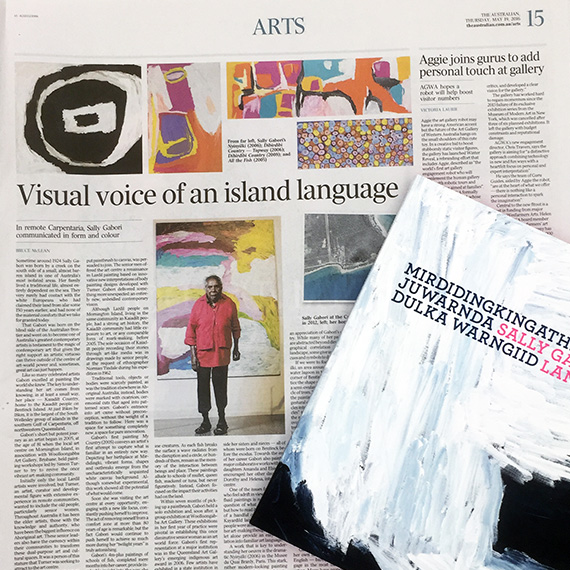
Enjoy reading about Sally Gabori, a senior Kaiadilt artist from Bentinck Island, and an exhibition of her work opening at the Gallery this weekend. QAGOMA’s Curator of Indigenous Australian Art Bruce McLean has drawn together more than 50 artworks painted since Gabori commenced painting at 81 years of age. In remote Carpentaria, Sally Gabori communicated in form and colour and this edited extract from the ‘Mirdidingkingathi Juwarnda Sally Gabori: Dulka Warngiid — Land of All’ catalogue is a taste of the visual feast that is the exhibition. As published in the The Australian (‘Visual voice of an island language’, Arts & Entertainment, 19 May 2016)
Sometime around 1924 Sally Gabori was born by a creek on the south side of a small, almost barren island in one of Australia’s most isolated areas. Her family lived a traditional life, almost entirely dependent on the sea. They very rarely had contact with the white Europeans who had claimed their land from afar some 150 years earlier, and had none of the material comforts that we take for granted today.
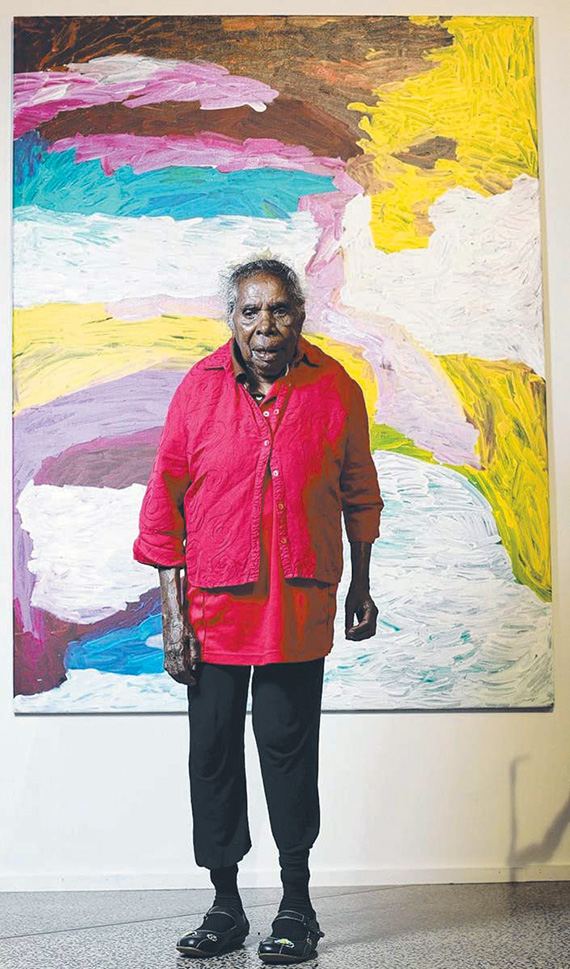
That Gabori was born on the blind side of the Australian frontier and went on to become one of Australia’s greatest contemporary artists is testament to the magic of contemporary art: that given the right support an artistic virtuoso can thrive outside of the centre of art-world power and, sometimes, great art can just happen.
Like so many celebrated artists Gabori excelled at painting the world she knew. The key to understanding her art comes from knowing, in at least a small way, her place — Kaiadilt Country, home to the Kaiadilt people on Bentinck Island. At just 16km by 18km, it is the largest of the South Wellesley group of islands in the southern Gulf of Carpentaria, off northwestern Queensland.

Gabori’s short but potent journey as an artist began in 2005, at the age of 81 when the local art centre on Mornington Island, in association with Woolloongabba Art Gallery, Brisbane, held painting workshops led by Simon Turner to try to revive the once vibrant art-making community.
Initially only the local Lardil artists were involved, but Turner, an artist, curator and developmental figure with extensive experience in remote communities, wanted to include the old people, particularly senior women. Throughout Australia it has been the elder artists, those with the knowledge and authority, who have been the biggest influence on Aboriginal art. These senior leaders also have the currency within their communities to transform these dual-purpose art and cultural spaces. It was a person of this stature that Turner was seeking to attract to the art centre.
With the help of then art centre manager Brett Evans, Turner convinced two groups of leaders to attend his workshops. The first were the senior Lardil men. At the second workshop, Mirdidingkingathi Juwarnda Sally Gabori, a small woman known mostly as a weaver from a community that had never put paintbrush to canvas, was persuaded to join. The senior men offered the art centre a renaissance in Lardil painting based on innovative new interpretations of body painting designs developed with Turner. Gabori delivered something more unexpected: an entirely new, unbridled contemporary vision.
Although Lardil people on Mornington Island, living in the same community as Kaiadilt people, had a strong art history, the Kaiadilt community had little exposure to art, or any comparable form of mark-making, before 2005. The sole occasion of Kaiadilt people recording their stories through art-like media was in drawings made by senior people, at the request of ethnographer Norman Tindale during his expedition in 1962.
Traditional tools, objects or bodies were scarcely painted, as was the tradition elsewhere in Aboriginal Australia; instead, bodies were marked with cicatrices, ceremonial cuts that aged into patterned scars. Gabori’s entrance into art came without preconception, without the weight of a tradition to follow. Here was a space for something completely new, a space for pure innovation.
Gabori’s first painting My Country 2005 conveys an artist’s first attempt to capture what is familiar in an entirely new way. Depicting her birthplace at Mirdidingki, vibrant forms, shapes and outbreaks emerge from the uncharacteristically unpainted white canvas background. Although somewhat experimental, this work showed all the potential of what would come.
Soon she was visiting the art centre at every opportunity, engaging with a new life focus, constantly pushing herself to improve. The act of removing oneself from a comfort zone at more than 80 years of age is remarkable, but the fact Gabori would continue to push herself to achieve so much more during her “twilight years” is truly astonishing.
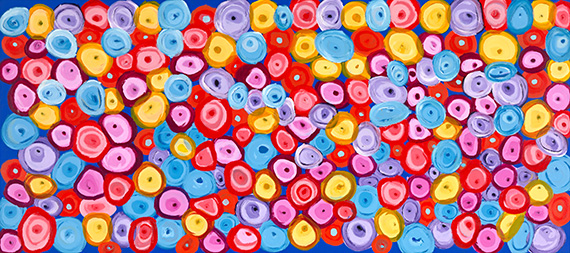
Gabori’s 4m-plus paintings of schools of fish, completed mere months into her career, provide invaluable insight into the way she viewed her world. These works, with hundreds of conjoined concentric circular forms jostling for space within the picture plane, conjure a large school of fish erupting from the bountiful reef-laden waters around Bentinck Island to feed on smaller fish or other marine creatures. As each fish breaks the surface a wave radiates from the disruption and a circle, or hundreds of them, remain as the memory of the interaction between beings and place. These paintings allude to schools of mullet, queen fish, mackerel or tuna, but never figuratively. Instead, Gabori focused on the impact their activities had on the land.
Within seven months of picking up a paintbrush, Gabori held a solo exhibition and, soon after, a group exhibition at Woolloongabba Art Gallery. These exhibitions in her first year of practice were pivotal in establishing this once diminutive senior woman as an art world force. Gabori’s first representation at a major institution was in the Queensland Art Gallery’s emerging indigenous art award in 2006. Few artists have exhibited in a state institution in their first year of practice, but even at the early stages of her career, Gabori’s energy was irresistible.
In 2007, inspired by a return to country, Gabori led a monumental effort to map many important Kaiadilt places through three epic 6m long collaborative paintings alongside her sisters and nieces — all of whom were born on Bentinck before the exodus. Towards the end of her career Gabori also painted major collaborative works with her daughters Amanda and Elsie, and encouraged her other daughters, Dorothy and Helena, into the art centre.
One of the issues facing those who feel adrift in viewing Gabori’s fluid paintings is not so much a question of what she is painting but how to read it. Gabori was one of a handful of speakers of the Kayardild language, so very few people were able to fully penetrate her art-making thought processes, let alone provide an easy translation into familiar art language.
A work that is key to understanding her oeuvre is the dramatic Nyinyilki 2006 in the Musee du Quai Branly, Paris. This stark, rather modern-looking painting of black and white concentric circles seems abstract enough to be considered in the trajectory of postmodern artists. On closer inspection, however, and with deeper research, another story emerges; a simple internet satellite map service allows us to gain an appreciation of Gabori’s country. While many of her paintings are abstracted beyond direct topographical correlation with the landscape, some give us important cues and symbols to decipher.
If we were to focus on Nyinyilki, an area around a large freshwater lagoon in the southeastern corner of Bentinck Island, we notice the shape of the lagoon inside a semi-ovular bed, fringed by a circle of trees. When we look back at the painting, it transforms from a gestural exercise in concentric circles into something else. The “circles” take on different shapes — the rectangular lagoon, the semiovular bed, the circular fringe of trees — as the painting morphs into a story about a place.
There are three physical elements that are unavoidable and ever present on Bentinck Island — the land, the sea and the sky — each encoded in Gabori’s paintings. The land and sea hold many of the important places, stories and memories already discussed, but the impact of the sky is less acknowledged. Many of Gabori’s paintings resemble the organic shapes and structures of clouds, from waiflike nimbus forms to menacing shapes that evoke the destructive cumulonimbus, the bringer of storms. Later in her career, Gabori painted many darker works, often just using subtle variations on a monochromatic black and white theme. Many of these paintings embody an almost sinister energy.
Gabori almost always spoke her own language and had little English — barely enough to engage in the most basic conversation. Many have proposed that painting became a new language for her. Unable to connect with the outside world in her dying tongue, her works invited us into a world we would otherwise never have been able to access. However it is crucial to note that in each of her works Gabori is not engaging an audience but communicating with her land and family. She invites us to witness the creative residues of these intense personal connections.
Gabori often broke out into Kaiadilt song and dance, sometimes spontaneously, but often when finishing a work or being reunited with her important major paintings.
One particularly moving instance was during the media preview of ‘unDisclosed: 2nd National Indigenous Art Triennial’ at the National Gallery of Australia in 2012. A wall filled with her monumental paintings, including My Grandfather’s Country 2009, compelled Sally to rise from her wheelchair to stand in front of her paintings and sing and dance.
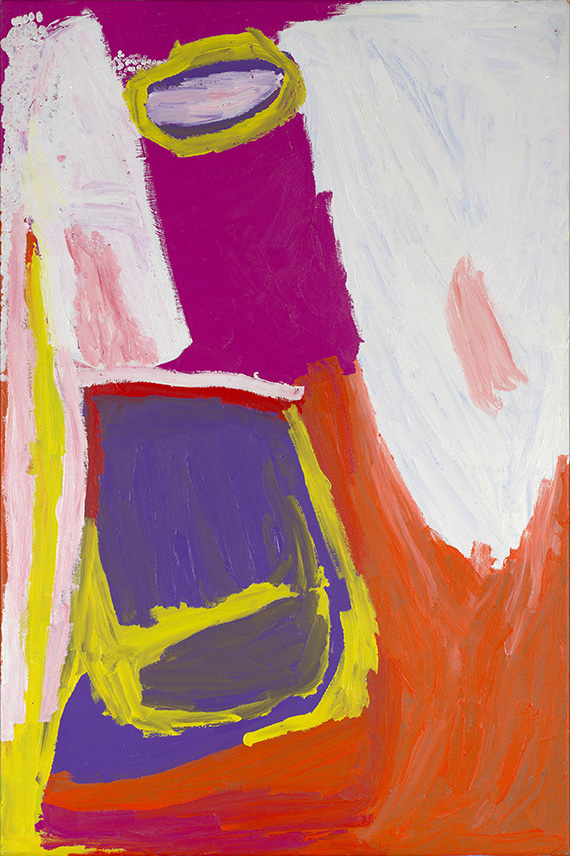

Gabori’s paintings, like this performance, stir a sense of love, loss and longing. When she paint her country she paints the memories of those places and the people who were connected to them through name. When she paints Thundi (Thunduyi), she paints about Thunduyingathi Bijarrb, her father. When she paints Dibirdibi Country, she paints about her beloved husband (Kabararrjingathi Bulthuku) Pat Gabori. And when she paints Nyinyilki, she paints about those people she fought alongside and returned to country with. Gabori’s paintings, although identified by place names, are equally portraits of the people who belonged to them.

